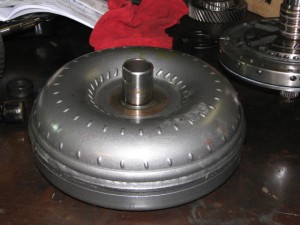
Torque Converters for Automatic Transmissions
If there were a vote for the most misunderstood automotive component, we’re willing to bet automatic transmissions would rank pretty high, and the torque converter itself possibly higher still. OK, so it’s kinda like a clutch for an automatic, but how does it work? And, what do stall speed and lockup mean, exactly? How do you choose the ideal torque converter for your project or driving style?
Lets start with the basics of how a converter works. It is essentially a modified fluid coupling that, like a clutch, allows the transmission to be disengaged from the engine, so the latter can still run while the car is stationary but allows power to be transferred when the car is in motion. Unlike a regular fluid coupling, however, a torque converter multiplies torque when there is a difference between input and output speed, similar to a reduction gear.
A torque converter consists of three major internal components: the pump, turbine, and stator, as well as transmission fluid. The housing of the converter is bolted to the engine’s flywheel, and the fins of the pump are attached to the housing. This is a centrifugal pump, throwing fluid outward as it spins. This creates a vacuum that draws more fluid in at the center. The fluid then enters the turbine, which is connected to the transmission via the output shaft, so the trans starts to move the vehicle when the turbine starts to spin.
When the fluid exits the turbine, it is moving in the opposite direction to that of the engine and the pump. It is the function of the stator, which is located in the center of the torque converter, to redirect the fluid before re-entering the pump. The stator is mounted on a fixed shaft but has an internal one-way clutch, since it is required to freewheel at certain operating
A torque converter has three stages of operation: stall, acceleration, and coupling. Stall is when the transmission is in gear, but the brakes prevent the car from moving. At stall, the torque converter can produce maximum torque multiplication, called stall ratio, if sufficient input power is applied.
The acceleration stage sees the car moving but a relatively large difference between pump and turbine speed, where the converter will produce torque multiplication that is less than what could be achieved under stall conditions.
Coupling is when the turbine reaches roughly 90 percent of the speed of the pump. There is no more torque multiplication, and it would be at this stage when a lockup clutch would kick in. Lockup converters have an internal lockup clutch that will lock the two halves of the torque converter together, eliminating any slippage where the engine and trans cannot physically operate at the same speed. This, in turn, eliminates any wasted power and so improves fuel efficiency by as much as 65 percent.
Part-2 about torque converters coming soon, stay tuned in. Don’t forget that GotTransmissions.com includes a rebuilt torque converter with every one of the transmissions for sale. Call us at 866-320-1182 and find out more about our top quality replacement transmissions.


